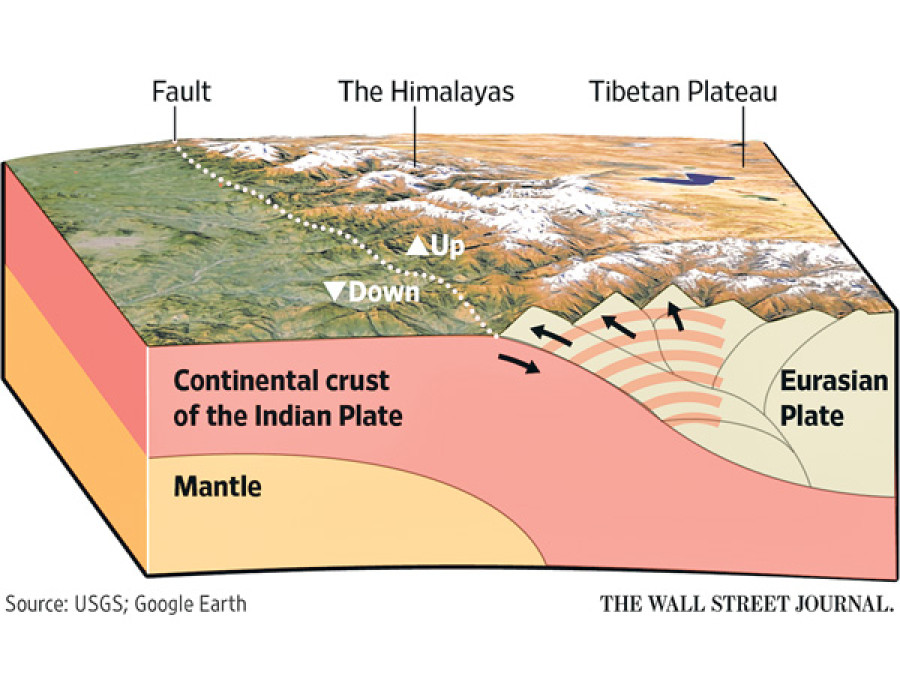Opinion
Beyond science
Earthquakes are complex geophysical phenomena and we have to accept the fact that quakes in the Himalayas are mind-boggling, even to scientists
Gyanendra Gurung
The 7.3 magnitude aftershock that struck on May 12 triggered fresh fears among the public, sparking panic about a larger impending quake. At the same time, an angry mob emerged on social media, targeting the scientific community for not incorrectly assuring that another big quake was not due until far in the distant future. To make matters worse, further misunderstanding of the magnitude scales—a matter not remotely useful in times of crisis—washed away any remaining trace of credibility for the experts.
Different scales
From the very beginning, it was clear that people definitely had little knowledge about magnitude scales, and those who did, did little to shed any light on the matter. After all, magnitude scales, despite being intuitively appealing, are downright annoying on a practical basis.
First of all, there are many different scales to choose from and they all differ on the specific type of seismic parameter that you measure, and not—as was apparently the rumour—different for different countries. Second, to compare the strength of two earthquakes, you have to use the same units; you cannot compare apples with oranges.
As soon as any quake occurs, the United States Geological Survey (USGS) posts its location, magnitude, and depth. The values posted for the April 25 and May 12 earthquakes are 7.8 and 7.3, respectively. Both of them use the same ‘moment magnitude’ scale—abbreviated as MWW—and it is not the Richter magnitude scale. Nobody uses the Richter scale (also known as local magnitude, ML) for measuring large earthquakes, because it underestimates the energy of any earthquake above a magnitude 7.0. The Richter scale can be used to measure earthquakes smaller than magnitude 7.0—preferentially less than 6.5. But to start comparing the magnitude 7.8 earthquake of April 25 with the May 12 with 6.8 on the Richter scale will not only yield a wrong comparison, but will end up downplaying the actual intensity of the Tuesday’s aftershock.
Were scientists wrong?
The aftershock of May 12 invited a lot of scorn towards the scientific community. People were upset as to why scientists were not able to predict this earthquake correctly. But how could they? Current scientific knowledge does not allow deterministic earthquake predictions, ie, to accurately predict the year, month, day, location, magnitude, and depth. There were even reports of ‘viable precursory tell-tale signs’ before the Tuesday aftershock. To date, there is no scientific evidence to support such precursory behaviour; it might have happened once or twice, but it has not happened all of the time. Moreover, the region of the Tuesday aftershock was queued up in the sequence of the hundreds of the aftershocks that were occurring in that particular area. It only happened to release a larger amount of energy than the preceding aftershocks, but it was still smaller than the main shock of April 25.
As is often the case, communicating information based on scientific research to the public can create a lot of misinformation. When geoscientists talked about the next big one not happening for a long period of time, they were not talking about this aftershock but rather, the likelihood of another separate large event to occur in the distant future. Moreover, they were not making any predictions, but rather mentioning a probability based on their observations. Scientists have been following the pattern of historical earthquakes in the Himalayas and they have found that there is some regularity to the recurrence of these earthquakes. So, the Tuesday event was an aftershock and not the big one, which is still anticipated in the distant future. However scientific understanding changes with new knowledge and the April 25 earthquake—as we shall learn later—could have tweaked this historic pattern and shed new light on Himalayan geology.
It is a very difficult problem for us scientists to provide people with information that is uncertain and based on probability. Therefore, we need to be very humble with our data from the very beginning. As scientists, we have to tell the public what we know and what we do not. In cases like natural disasters, we have to very upfront with what we do not know. We know that there is no way to test the probabilistic forecasts that we make—even with the best and reliable scientific data at hand. But, as is often the case, the public will listen—and talk about—what we know and simply forget what we do not know. Therein lies the tragedy.
Earthquakes are complex geophysical phenomena and we have to accept the fact that quakes in the Himalayas are mind-boggling, even to scientists themselves. To make matters worse, the earthquake of April 25—based on the distribution of stress over the rupture surface—displays a new pattern; it ruptured in a place where it shouldn’t have, ie, a place that scientists had so far believed to never rupture at all. There lies the fun in science—with new knowledge comes new understanding. This has led everyone to believe that the current earthquake could probably be a precursory foreshock to a much bigger one. But again, we have to understand that this is a probability and we have to wait and see if it is true. But, if it does turn out to be true, then it will have very interesting implications for future earthquakes in the Himalayas.
How long will aftershocks last?
In general, we assume that earthquakes occur randomly in time. But they do not. Earthquakes are dynamic processes and integral to mountain-building. But here is an interesting fact—a month ago, before the April 25 earthquake, did you know that you had been living in the aftershock period of another large earthquake? It could have been anyone of the large ones—the Sikkim-Nepal earthquake of 2011, or the Udaypur quake of 1988, or the Great Nepal-Bihar earthquake of 1934. So, these aftershocks should not—forgive the pun—come as a shock.
So, when will the aftershocks cease? They might end. If they indeed stop, then that means a big earthquake has occurred elsewhere and the whole cycle is repeated; a large number of aftershocks in the first few days gradually decrease in number and magnitude over time (as per Omori’s law).
One more thing we have to remember is that large earthquakes are not a single point in space and time; they are actually large surfaces with finite length and width. If you look at all of the aftershocks following the April 25 earthquake, you can easily get a glimpse of its size: a somewhat rectangular surface, roughly extending somewhere from the westernmost bounds of Gorkha to the eastern bounds of Sindhupalchowk. All of that area is the actual earthquake! Similarly, all historical earthquakes that happened at different times are also represented by big rupture surfaces underneath the Himalayas, and the interesting, but confusing, fact is that they all interact with each other. So, the slip in this current surface is definitely putting tension on the surrounding surface, but which one? We will have to wait for detailed analysis from experts.
Science and society
In the aftermath of the disaster, we have seen everyone bringing out the best in themselves and working together for the common good of the people. In such times, we scientists have a responsibility to be as humble as possible and not resort to exaggeration. Otherwise, our arrogance will completely erode the credibility of science. We have to be clear and coherent with our explanations because we are dealing with a natural phenomenon that has no certainty. Its prediction would be of great societal value but we do not have any scientific means to do so yet. Till then, we have to tell the people clearly what we know and what we do not. Otherwise our selfish actions will only promote charlatans to preach doom and drag the public to chaos.
Gurung is a Doctor of Science in Geophysics and a Post-doctoral Research Fellow at Chonbuk National University, South Korea




 21.12°C Kathmandu
21.12°C Kathmandu










